




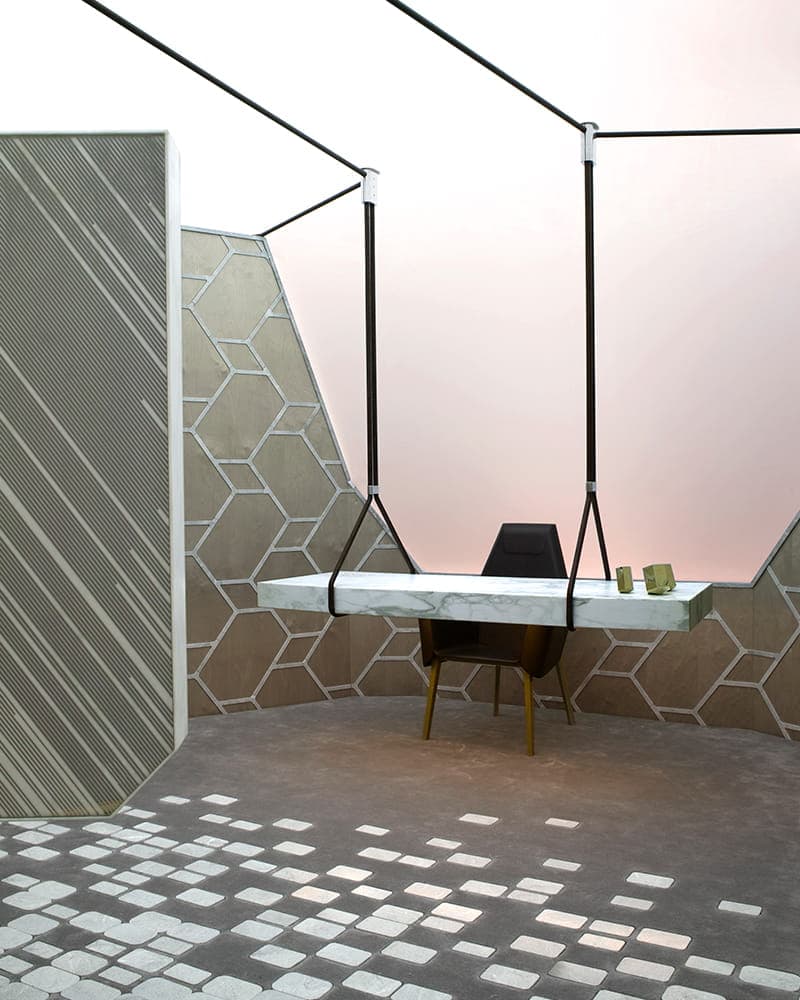

Founded in 2010 by Ramy Fischler, RF Studio is a design agency in the broadest sense of the word, focusing on the worlds of home, work, hospitality, entertainment and new technologies. Some of their most striking projects – either recently completed or upcoming – are National Café (the National Gallery restaurant in London), the Parisian community kitchen Reffetorio, the Eiffel Tower Brewery, Novotel Hotel’s new brand design, the scenography of Hamlet at the Paris Opera, and the new headquarters of Twitter France. The studio has dealt with diverse and synergistic topics enabling them to develop their expertise on innovations and new practices that can transform lifestyles.
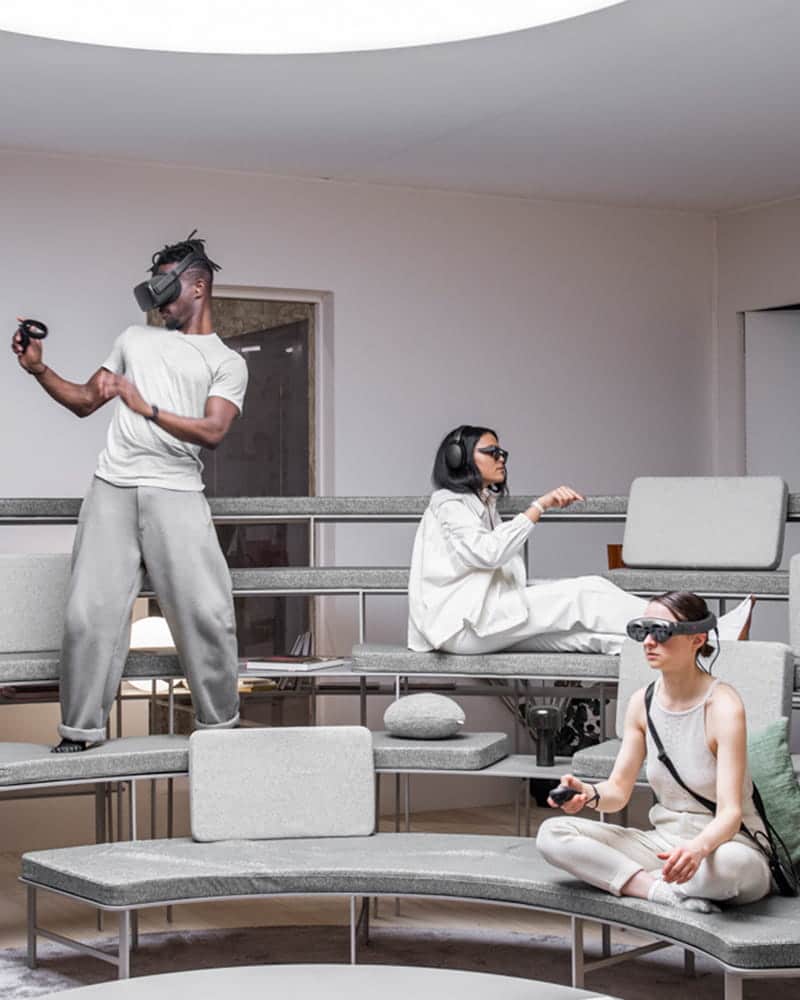

In 2017, RF Studio created Bureau des Usages under the direction of Scott Longfellow. As a research and development unit, BU is constantly working to strengthen its shared intelligence to benefit all the studio’s projects. Specializing in design fiction, the use of fiction as a vehicle for communication and a place to explore possibilities is a key tool for BU.
Projects stem from current visions of the future and also expected visions by creating characters in speculative scenarios and testing them in different futures. We are talking here about human scale and time. This forward-looking approach to strategic design contextualizes the work of design and formalization and also allows project partners to manifest their visions.

Co-curator of Sens-Fiction
Founder of RF Studio and Bureau des usages
Ramy Fischler is a Belgian designer based in Paris. A graduate of the ENSCI-Les Ateliers, he collaborated with Patrick Jouin until 2009, when he was awarded a residency at the French Academy in Rome. As a 2010 to 2011 resident at Villa Médicis, he led an in situ reflection on the hosting of visitors and artists within the institution. In 2010, he founded RF Studio, a multidisciplinary design agency that today has a staff of around thirty. In 2016, he was given the distinction of Chevalier of the Order of Arts and Letters. Since 2017, he has also been in charge of architectural creations for Chanel, Perfume & Beauty and Watch & Jewellery.

Co-curator of Sens-Fiction
Director of Bureau des usages
Scott Longfellow has degrees in both political science and creative industries management. He quickly specialized in design, convinced of its transformative potential for companies. For seven years, he managed the Designer’s Days Association and programmed its festivals. He has curated several exhibitions and was a professor at the French Institute of Fashion. In 2017, he joined Ramy Fischler to create the Bureau des Usages, a unit for planning and speculative design linked to the agency.

In 2019, RF Studio and Bureau des usages – its in-house research unit – embarked on the development, as part of Lille Métropole, World Design Capital, of an exhibition that explores the role of imaginary vision in predicting future habits. Why should we care about imaginary visions, futuristic tales, and the power of fiction, as designers in 2020? Because fiction influences human behavior and, in the end, transforms our everyday lives.
To understand its impact on each of us, we must observe the cognitive processes, psychological effects, and emotional reactions that take place when we are taken in by the power of a story that transports us. We must also distinguish between the multiple background elements of a given era, which populate a fictional tale, depending on its socio-economic challenges and scientific advances.
We’re quite confident that this contextualization is key to humans’ ability to adapt to technological evolutions and shifts in values and habits that can nevertheless shake up our everyday existence. Being aware of the sometimes unseen connections that unify, in a common trajectory, imaginary visions, industry, the economy, or science, sharpens our critical view of the past and helps us, within our work as designers, take on the challenges facing our own era.
One thing is clear: these tales of the future, which forge a collective unconscious and allow us to project ourselves into the future; these forward-looking fictions, though they may have evolved in how they deal with certain subjects, remain committed to certain narrative structures, and often place the future into the hands of technological progress, for better or for worse.
And yet, our knowledge of the world, our aspirations, ambitions, and needs, have completely changed. What’s happening now, in our time, that is preventing us from looking ahead and inventing new world visions, as was done in the early 20th century? Can the designer, as a vector for change, be active in providing alternatives to the dystopian world view that currently predominates? In a word, is it possible to break out of this lack of imaginary vision?




Though literature has been exploring parallel universes and alternate realities for centuries now, the advent of the industrial age would radically accelerate the use of fiction to foreshadow the world of the future.
The emergence of cinema would enhance the popularity of futuristic tales, in a world fascinated by technology and innovations. The 1910 short film “Matrimonio interplanetario”, directed by Yambo (AKA Enrico Novelli), is a perfect example of this. The love of an earthling, Aldovino, for a Martian girl is made possible through technology: he falls in love by telescope, asks for her hand in marriage via telegraph, and manages to join his beloved with a spaceship shot into the great beyond by a launcher.
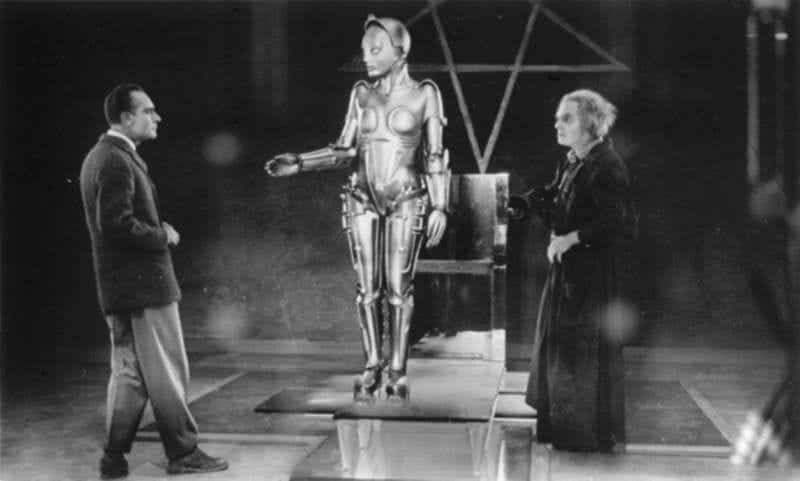
Among the intellectuals, artists, and researchers of their time, voices nevertheless emerged against the possible excesses of this blind faith in progress, with Fritz Lang leading the charge. But this counterculture would not stop the technophilic energy that would come to dominate public opinion and boost industrialists in their advance toward the promise of comfort provided by machines. From the early 20th century, collections of illustrations published by consumer brands (chocolate, cigarettes, whisky, etc.) foreshadowed our current practices and presented a vision of everyday life in the future (mobility, health, communications, food, etc.).
The future and its promises of comfort and a better life entered the world of consumerism. These anachronistic goodies reflect an incredible belief in superhuman progress, and highlight the unknown elements within the dreams of a certain era. This craze would foster considerable productivity by illustrators, writers, and film directors, committed alongside brands to promote this desire for a world of the future, in order to sell, primarily, the here and now. Storytelling, like any belief system, is able to generate collective acceptance that fosters desire, as well as new needs.In the United States of the 1920s, Fordism created a stolid middle class, while the electrical genie was making its way into homes; for the first time, most of the population was able to fully experience a commercially accessible future and feel that all the promise of a world to come was revealing itself. While the West experienced one economic crisis and war after another, science fiction, futuristic tales, and a brighter tomorrow, the spearheads of innovation and mass consumerism, fueled the imagination that powered economic growth. At that time, interdisciplinary creative labs were founded, allowing for experimentation on possible future developments. Design found its place and its usefulness as part of this life-saving enterprise that would rescue the economy and foster miraculous growth for the entire Western world after the Second World War.
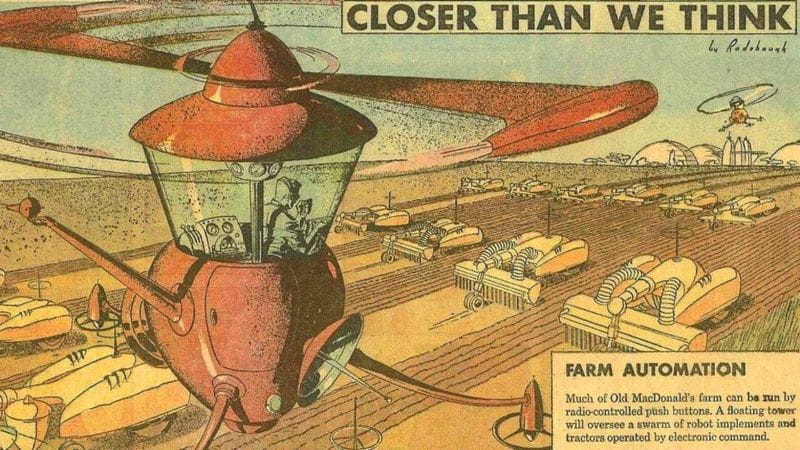
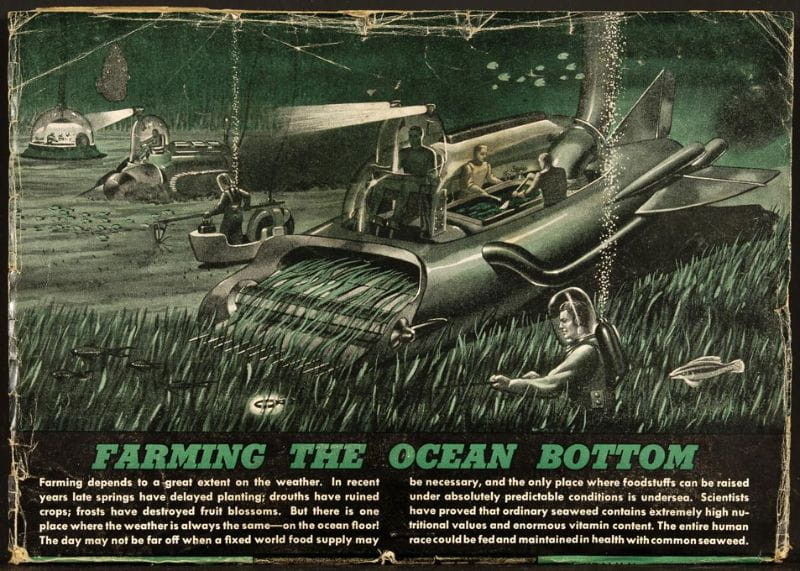

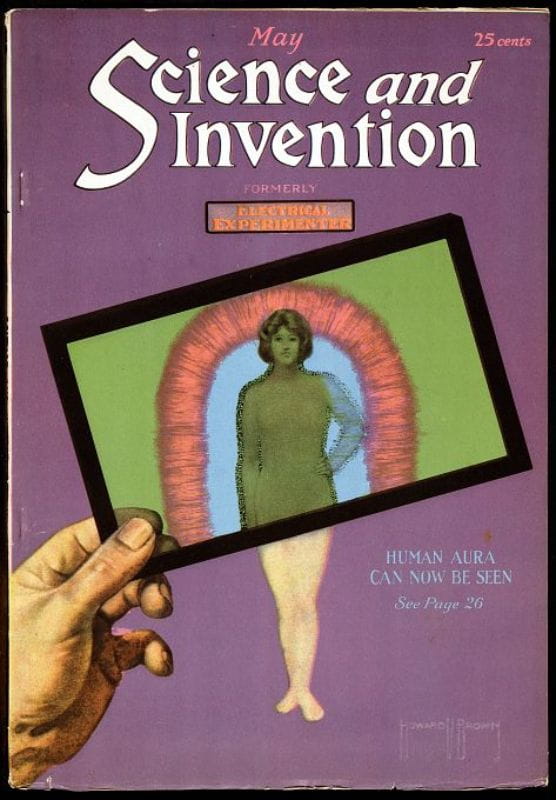
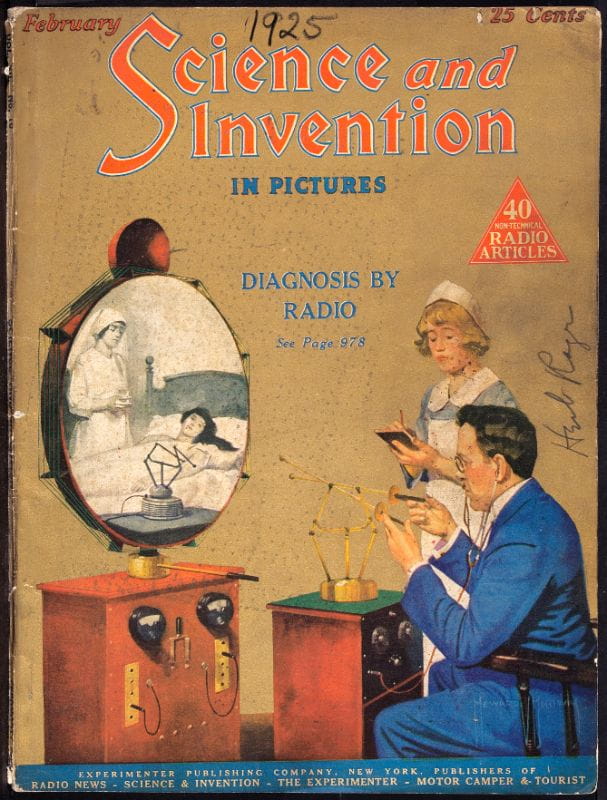
Hugo Gernsback undoubtedly best embodies the emergence of this trend, and his contribution would only enhance it. This inventor-entrepreneur, originally from Luxembourg, would leave his mark on this era through his futuristic vision of a better world, a vision fed by technological progress and the contributions of modern science.
As the inventor of the term “Scientifiction” (in the pulp magazine Science and invention in August 1929), he devoted himself to envisioning the future of earthlings, inspired by emerging scientific research and applying its benefits to the improvement of everyday life: wireless communications, distance health care, augmented entertainment, or flying transport…such were the many possibilities that this inventor detailed, illustrated, and imagined within a world to come, in the form of trademarked inventions or popular stories. Some of his creations are now part of our everyday lives, and others are about to be, such as urban heliports, the fact being that his imagination never strayed too far from reality or, perhaps, that reality was largely inspired by his visions.
Gernsback was convinced that, the faster his concept of the future was known to a wider audience, the greater the chance it would come to pass. He thus founded his own publishing house and published forward-looking stories in pulps, magazines made from cheap paper pulp, easy to obtain, inexpensive, and easy to understand. These magazines with their illustrated covers published stories that made every reader imagine they were in them, regardless of their age or level of scientific knowledge. Pulp magazine Science and invention from 1921 presented augmented reality on its cover, with an illustration by Howard Brown announcing the new “Human Aura”, just as cryogenics were announced on the cover of the very same magazine some time after, in September 1925’s “Life suspended in ice”.
Making all his predictions on the coming shifts in uses, practices, and lifestyles accessible, Gernsback quietly established design practices that are still in use today. He paved the way for a hypothesis that would truly make inroads: a certain vision of the future has a greater chance of coming true if the story one tells about it is inspiring and desirable and if, well before its incarnation, it is embraced by the public.
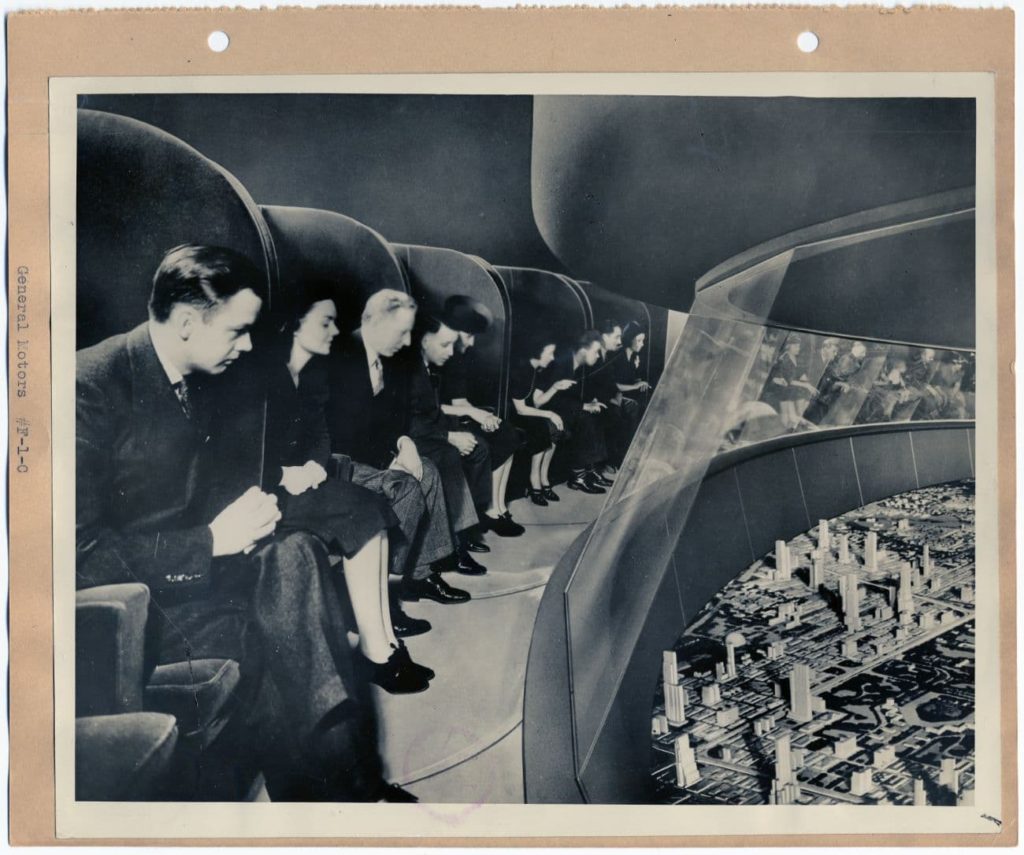
Surprise thus becomes expectation, and industry takes over to transform the experiment. Thus begins a period of absolute confidence in technological progress and imagination: brands and designers would take advantage of this approach to promote a perfect world, comforted by desirable imaginary visions of the era, such as the automation of domestic appliances, individualized, rapid, and spacious transport, and telecommunications for all. The narration takes on the shape of an ad campaign, with goodies, collectible illustrations, even exhibitions, which many designers took part in, including the Eameses, Robert Dreyfus or Norman Bel Geddes.
The latter, at the time a brilliant set designer on Broadway, is an eminent representative of Streamline style, the very first purely American design movement that established an esthetic that advocated the speed of progress and aerodynamic shapes. N. Bel Geddes would stand out by contributing to the greatest large-scale event production devoted to future habits and uses. New York, on the cusp of the Second World War, hosted the World’s Fair, entitled “The World of Tomorrow”. It was entirely dedicated to a look ahead at everyday life in the future, made possible by the evolution of techno-sciences. The public came in droves to see the future here.Norman Bel Geddes created the design of “Futurama”, an immense diorama commissioned by General Motors. Each day, 70,000 visitors would experience the future here by literally entering a three-dimensional story that took them through the city in 1960. The public took a seat in small remote-controlled seats and began a narrated journey lasting 16 minutes, at 2 km/h. First, it hovered over a 1/500-scale model of the city, then entered a home and a business of tomorrow. A total area measuring 35,000 m2, where you could discover truly life-like robots, fully equipped kitchens, and household appliances with unbelievable capabilities.
One may doubt the purely philanthropic intentions of this investment by an automotive powerhouse. This type of popular initiative gave the brand unprecedented visibility, plus the sympathy and legitimacy which allowed it to increase its industrial productivity. In doing this, it shaped the world to the full advantage of its industry. Being in touch with an unreal, though palpable world that was just within reach would accelerate the public’s dependency on change, as well as its desirability…
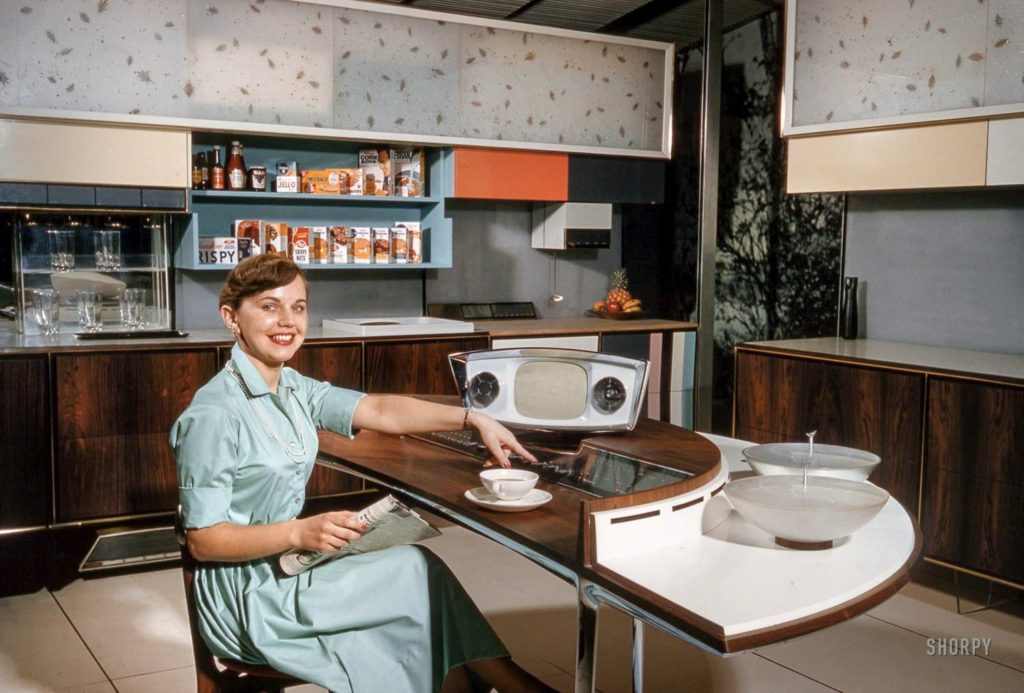
Once in public view, some of these innovations would undoubtedly turn out to be more successful than others; and so, the time came to review and refresh these concepts. Let’s take, for example, the Miracle Kitchen, a system promoted by RCA and Whirlpool, which traveled the world in the 1950s and made an appearance at the National American Exposition in Moscow in 1959, in the midst of the Cold War. This kitchen presented a future where everything would be controlled through the simple touch of a button, so that, according to the exhibition’s slogan, “All that women don’t like doing would be done automatically”: an autonomous robot-vacuum cleaner, a fridge that manages its contents on its own, a precursor to the Thermomix…it’s all here, except, of course, the technology that would allow for the production of these objects.
Thus, the combination of fiction, innovation, and industry had the advantage of consolidating the belief system of an era, of shaping it, bringing it to life, and of taking plausible or desirable imaginary scenarios into the realm of concrete truth. Spaceships, robots, parallel universes, connected objects, and many other 20th-century inventions went from dream to reality through popular fiction, which made them real and accessible to the widest possible audience. Many films and events were created in order to promote or amplify these popular celebrations of progress.
An iconic example of this is the animated film “All’s fair at the fair” by Max Fleischer Studios, announcing the 1939 World’s Fair. In it, we see a provincial couple from down on the farm arrive at the gates of the exposition in a wagon. There, they discover all sorts of robots taking care of everyday tasks: harvesting, preparing meals, construction, wellness. After a little spin around the dance floor, the couple departs all decked out in an automobile purchased and assembled on site, with their happy horse now comfortably seated in the trunk of the car.
A 1957 docu-fiction tells the story of a family’s visit to the “House of the Future” attraction in Walt Disney’s Tomorrowland park. The entire family is amazed by what they discover, and each of them imagines living in this house and interacting with its appliances, which would make everyday life easier and allow for an entirely new way of living.
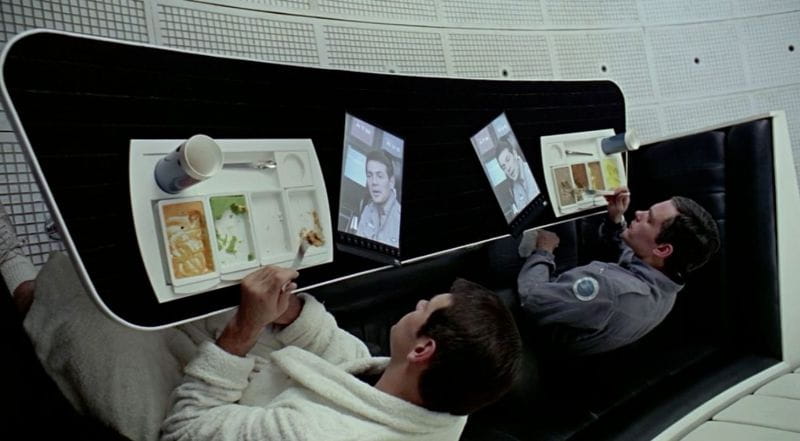
This popular belief in the liberating power of technology to bring us a comfortable life would expand through to the 1960s, a time when the cinematic arts of science fiction would unfurl, comics would find a larger audience, and futuristic literature would become a genre of its own. Cultural content would expand the reach of these visions even further and describe objects, practices, and situations which, on Earth or in a faraway galaxy, would echo the prescient imaginings of H. Gernsback. Amongst the most memorable works, we can mention “2001: A Space Odyssey”, a film that has become a cult classic, in which one scene predicts lunchtime in space, where each astronaut with his meal tray watches his individual screen tuned to the BBC; this represents a digital object and individualist stance that, 40 years hence, would come to dominate the world as a matter of course.
The first appearance of the mobile telephone took place in New York in 1973. Martin Cooper, head of R&D at Motorola, concerned about the growing competition from AT&T on the car-phone market, developed the first cellular telephone. The boss was said to have been inspired by the communicator used by Captain Kirk in “Star Trek”. The brand’s tribute to this space opera would be taken even further: in 1996, it presented the first clamshell mobile phone, the StarTAC, an identical copy of the object in the TV show. We would find the same analogies in dozens of fictions that would present, to flesh out the storyline, intelligent practices or robots, robot-driven medical equipment, new industries, or autonomous transport vehicles, formalized in a bewildering amount of detail.
This clairvoyance, as well as directors’ ability to so clearly imagine the future, depended largely on the composition of their teams: these included aerospace specialists, automotive or telecom engineers, and, of course, designers. This entire ecosystem of experts was reminiscent of that of industrial firms, which availed themselves of the same skill set to develop their products. The most eloquent example of this may be Syd Mead, who, initially working for Ford, would build his career as a designer in science-fiction films from “Star Trek” to “Tron”, also working on “Blade Runner” and “Alien, The Return”. Here, we can also mention Alex McDowell, who, alongside Steven Spielberg, Tim Burton, and Andrew Niccol, would become a benchmark production designer: he would then develop the Building World Institute in Los Angeles, which brought together all the different areas of expertise in building parallel universes.
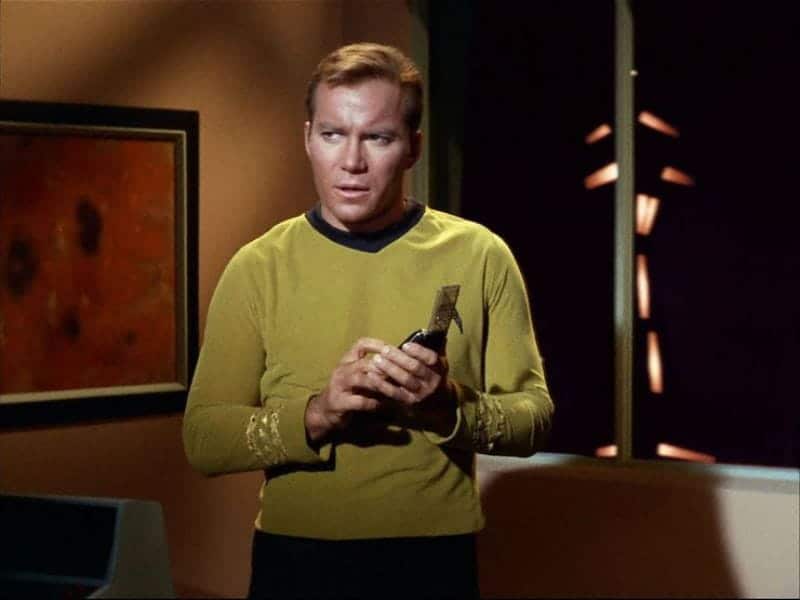
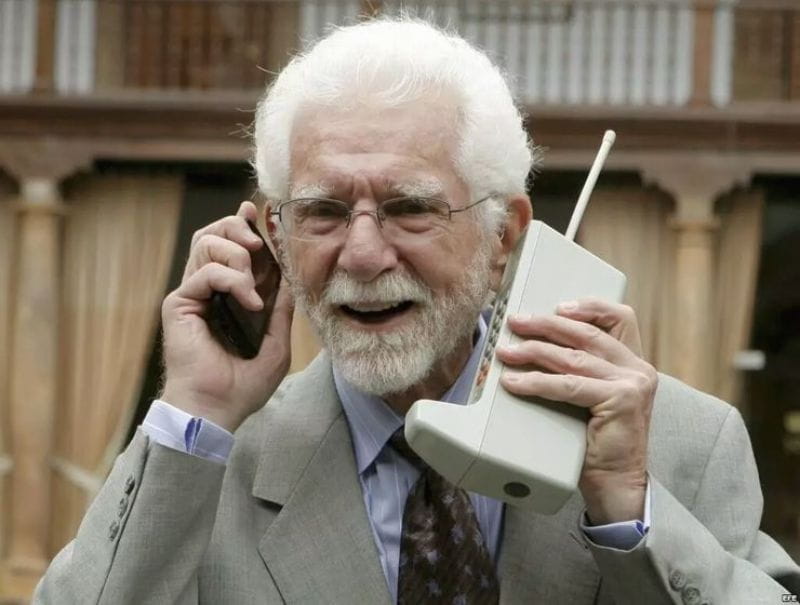

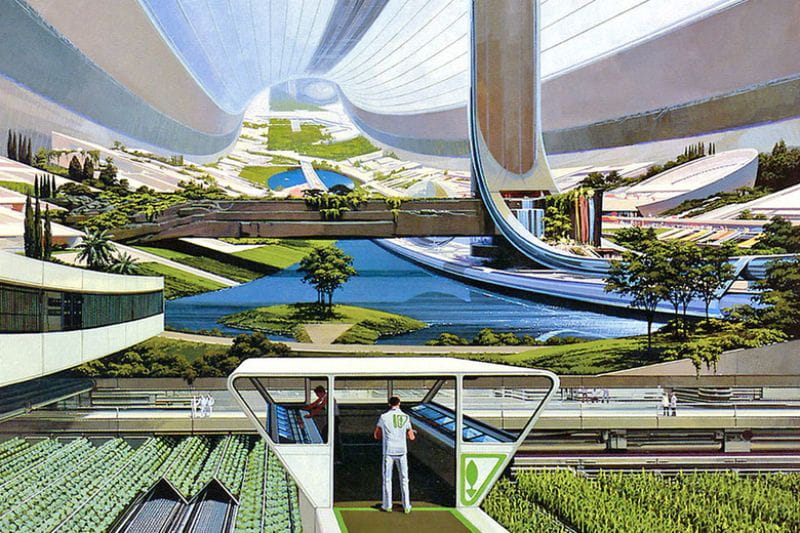
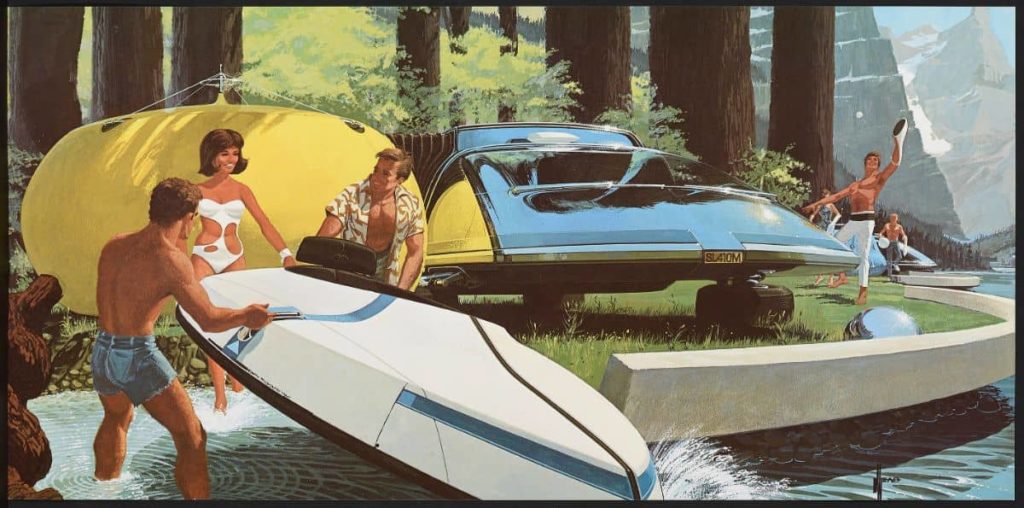
Though this linking of skills and ambitions allowed post-war fictions to precisely describe the world to come, it also partially facilitated, or even triggered, the introduction of these shifts into real life. Certain scenarios so strongly impacted hearts and minds, through entertainment, the cultural sector, and advertising, that they gradually became part of the collective unconscious of realities, remaining, until today, horizons to be reached.
Still, these technophile tales that so marvelously conveyed mid-century ideals, such as the emancipation of the middle class and the improvement of urban life, and which are now coming true, are no longer what is needed today, to escape a destiny that would seem misguided: colonizing planets, living with robots, chatting with an artificial intelligence system, escaping into a parallel universe, or inhabiting a vertical megalopolis…Such are the many utopias that were justified at the time in order to uphold a certain mythological construct that began with the Industrial Revolution and drove Western economies.
Since this foretold world is coming to pass, there is no longer any point in hiding or seeking to avoid it, just as it’s no longer possible today to deny the ravages of pollution or of climate change. The issues at stake and our knowledge of the world as it is and as it is about to become should lead us to break the cycle and restart on a fresh basis, using pathways pursued by alternate utopias. This is why, as a designer, understanding the mechanisms contributing to the creation of technophile visions and the way they have influenced generations of earthlings, not by coercion, but through collective belief, should shed light on current practices. The people of Earth are stuck in systems they themselves created, because, above all, and beyond anything rational, they follow the most compelling stories, the ones that make them dream.

“The future colonizes the present, because its promise generates a state of need and counteracts the freedom to envision several possible futures.”
Anthony Giddens
At the start of the 20th century, the Western world faced war and crisis, but also experienced industrial progress, a wider dissemination of the effects of technological shifts, and the actual application of scientific discoveries. This would transform its way of life. These beliefs and visions we have just outlined shaped mentalities, ideals, desires, and, in the end, the choices of the Western societies we have inherited.
Nevertheless, over the past few decades, it’s been possible, for anyone who moves among the industrial, technological, scientific, and cultural worlds, to perceive a divergence in visions of the world to come, an ideological gap that, unlike in the previous century, contrasts industrial challenges, economic ambitions, and technological progress with the permanence of our presence on Earth. The former have attempted to preserve the 20th-century model of growth, and the latter looked to change the model that has proven destructive for the planet. But beyond the facts and knowledge that we can no longer avoid and that should be leading us to make radical paradigm shifts, there remains an attachment to beliefs in the same imaginary visions that are preventing us from changing.
In other words, our civilization has grown so accustomed to a certain vision of the future, reinforced by various channels throughout an entire century, that it appears incapable of projecting itself into alternate futures. The utopias of yesteryear, in many futuristic tales, have become dystopias. A tension certainly exists and is growing within society. How can we keep dreaming of conquering the Moon when our own planet is burning? How can we keep fantasizing about driving a race car, when fossil-fuel energy pollutes and is running out? How can we dream of living in a megalopolis, at the top of a skyscraper, when contact with living beings is proving to be fundamental to our health and happiness? Why this fascination for augmented humans, humanoids, and other forms of genetically modified human beings, when everything seems to point to the fact that our species as we know it may not survive such mutations? Why choose industrial, altered foods, when natural plant life preserves our ecosystems and is better for our health? Why produce more than necessary, when we don’t even know what to do with all our waste? Who isn’t torn by these paradoxes whose reconciliation seems, both individually and collectively, impossible? What alternatives do we have to envision a future brighter than the one that seems to inevitably hang over our heads?
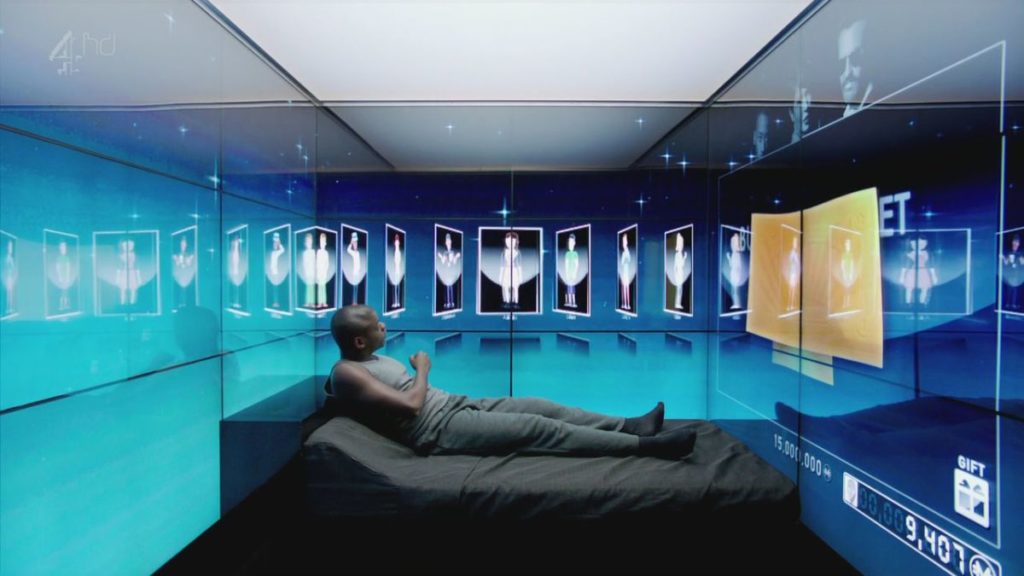
Where are the driving forces which, like last century, came together to show us new utopian visions? What are the stories, imaginings, incarnations, and myths that, like extraterrestrial epics, vertical megalopolises, or augmented humans, were created to take over and feed our conflicted hearts and minds? Though certain examples do exist, notably in non-Western literature (such as solarpunk and afrofuturism), our reservoir of desirable imaginings has reached a critical level, particularly in Western productions that infuse global popular culture: the production of imaginary visions, by a 21st-century yardstick, remains stuck on the last century’s favorite themes. And when it’s not spending time expanding on these technophile tropes, contemporary futuristic fiction is working hard to produce dystopian visions that more closely resemble probable realities than imaginary visions, and which few humans would describe as “desirable”…Even worse, the abundance of apocalyptic stories, whose relentlessly reiterated themes precisely illustrate a world where human life is definitively deprived of freedoms and is at the mercy of surveillance technologies, killer robots, or are slaves of virtual worlds, tend to normalize this subject and even its dangers, to the point of habituating the public, which then doesn’t question their implementation in the real world. Our relationship to algorithms is a perfect illustration of this; we’re entering the second Machine Age, when the machines speak to us in naturalistic language and not in binary code. Vocal assistants are a running example of this. Is the machine only helping us? No, in fictions, it often chats, sometimes shows a sense of humor, and, in many cases, makes the decisions. What could therefore be more natural today than accepting this agency of machines, without any doubt nor protection against abuses, malfunctions, nor dangers to our individual freedoms or against the risks of the future deterioration of human relationships?
Here, then, arises a fundamental question, which itself summarizes the entire goal of this approach: Are we capable of imagining a future world that is desirable, ideal, and safe, according to today’s criteria? Did the early 20th century not give us a guidebook for this? Wasn’t it marvelously successful at what we do not seem able to engender today, namely, new imaginary visions?

The 21st century is facing the new dangers of climate change, massive migration, pollution, and the disappearance of ecosystems vital to mankind and to the planet. Unlike the dangers we’ve known up to now, Earth’s inhabitants are facing problems that no solution and no legislation nor political authority can solve on their own. Only a collective, massive awakening, followed by comprehensive, radical action may prevent us from rushing headlong into a foretold disaster. But, until now, the energy we need to tackle this has not reached the level of the urgent stakes at hand. Petitions, demonstrations, blockades, and actions, as heartfelt as they may be, will not suffice to massively shift the mindset of a humanity that is too cautiously attached to the belief system it inherited. The failure of vision, that is to say, our collective inability to envision a future using creativity and inventiveness, seems to give way to overall paralysis.
And yet, history teaches us that only a monumental output of imaginary visions that are universally desirable and sufficiently widespread to reach all levels of society can change our destiny. If we examine the success of the previous century, we can easily see that the key to success was the alignment of essential components of our society: manufacturing, technology, science, politics, and creative design. Forecasting the future by omitting even one of these ingredients promises to lead to no conclusive outcome. This is what makes it so complicated, or even impossible, so difficult would it be to set simultaneous shifts in motion. Nevertheless, the advantage of imaginary visions is that they are not, by nature, designed to come true in an immediate future. On the contrary, their role is to inspire, to create yearning, and to foster vocations, and only then, actions that will come true in reality.
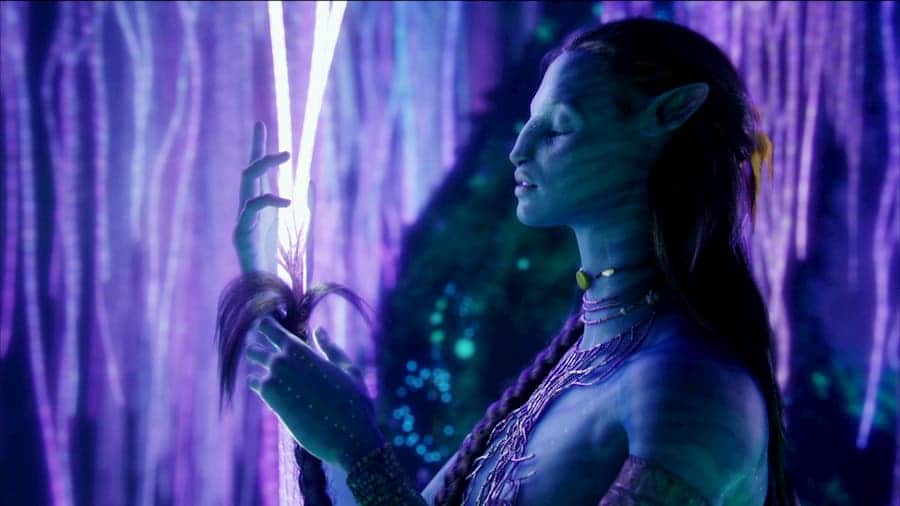
“Many of us believe, from our little wild oat patches, amidst the extraterrestrial cornfields, that, rather than giving up telling stories, it would be better for us to tell different ones, stories that people could keep telling once the old ones end. Maybe.”
Ursula K.Le Guin
Alternate visions of the future do exist, capable of using the performative power of storytelling to re-enchant our way of life. Many intellectuals from the worlds of philosophy, the humanities, and cultural studies are positing a shift in our vision as a research method: tracking as a philosophical method, for Baptiste Morizot, who, by looking at the habits of wolf packs, is attempting to expand our understanding of our interconnections with non-human living species; the desacralization of blood relations and intra-species biological links for Donna Harraway, who is advocating for the importance of relationships with companion species; landing in the critical zone for Bruno Latour, who is sketching out a pathway to progress by creating synergies within his living space, giving new meaning to one’s local area, based on the concept of generation. In the world of literature, some authors of science fiction, such as Octavia Butler, Nnedi Okorafor, or Brian Aldis, are shifting views on technology as a force for progress by questioning our relationship with the earth, time, and other forms of life, as a pathway to the future. A window has also opened within the industrial sector, which wants to reinvent its model before it becomes obsolete, so that it can face the challenges of its time, starting with environmental matters.
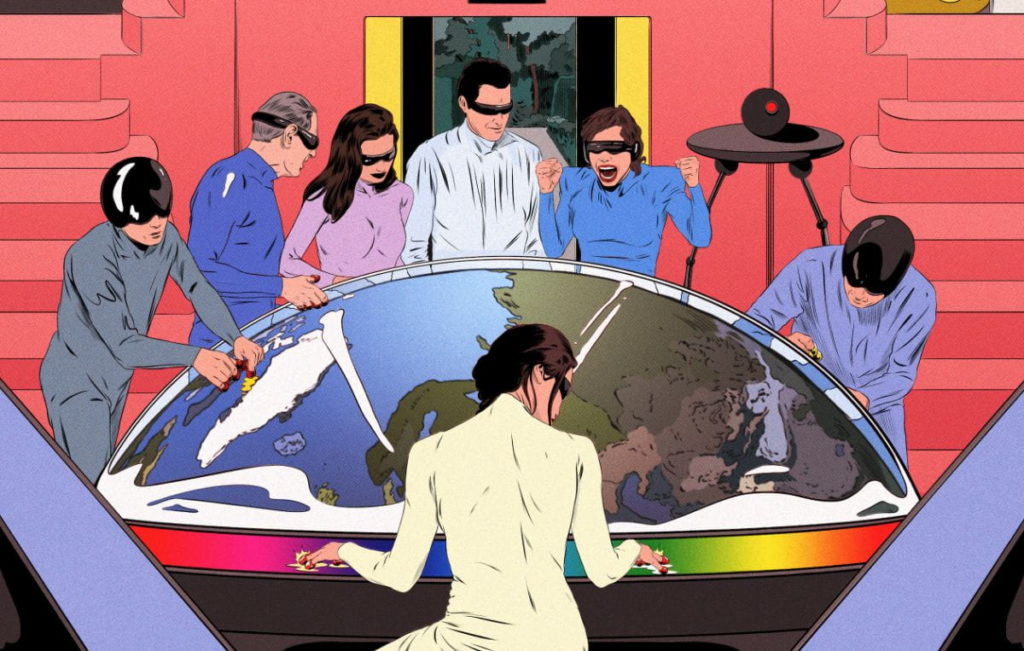
Design was created to work alongside industrial firms, scientists, and experts of every stripe, to reinvent everyday life and look ahead to the usages and practices to come; our commitment to the embodiment of desirable futures is thus natural and undeniable, as it has been throughout the past century. The use of narrative and fictional fields as tools for extrapolation also remains essential in our era to envisioning the world of tomorrow. The convergence of ambitions between the various industries involved in innovation, which has generated unprecedented productive energy due to the establishment of an unrelenting belief in technology, is certainly a thing of the past.
Other challenges are now facing the world, which will force a reevaluation of the place and meaning given to the consumption of goods, to the role of technology, the distribution of wealth and resources, and to scientific investigations. Nevertheless, it is not taboo to re-adapt a method that was successful, by creating imaginary visions that suit our era and reinventing the tales that reflect them.
Sens-Fiction was created with this in mind: rediscovering this collective, visionary spirit that once united industrialists, entrepreneurs, engineers, designers, and intellectuals, to imagine futures that excite us. From these popular tales of the 1930s, ‘50s or ‘60s, vocations and destinies emerged, along with a strong belief in a future that was essential to bringing society together. The limits of this dogmatic belief system are well known, but the fact of its performative power over our lifestyles remains. In short, it’s about time for other forces to be with us!
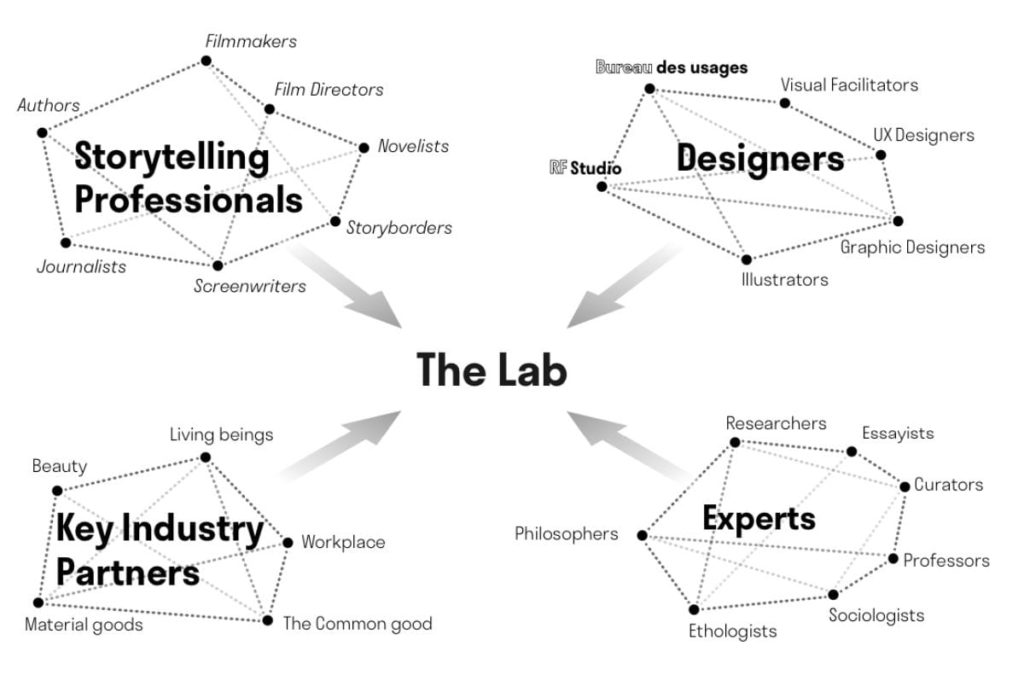
Bureau des usages is a division of the Studio, founded three years ago to support, as its name indicates, the exploration of new practices which, over the short-to-medium term, stand to transform our consumer, work, or housing habits, as well as our interactions with our environment. The use of fiction has swiftly proven to be essential in envisioning scenarios and persuading our partners of the feasibility of our proposals, at a stage that is too far ahead in the future to be decisively proven. BU’s business activities have rapidly diversified into the hospitality and work sectors, and into new real estate development concepts that blend a diverse array of uses and timeframes. It contributes a previously non-existent point of view to project ecosystems: expertise on shifts in expectations and usages which, in just a few years, have permanently transformed the way we think about spaces and the objects around us. For a year now, we have chosen to reflect on the role of imaginary visions in the emergence of innovations that transform our lives. Our belief that the time was right to participate even more actively in the creation of new futuristic storytelling has been reaffirmed. It’s a matter of embodying, as closely as possible, situations, environments, and moments of our everyday lives that will foreshadow what will emerge in the years to come, as we wish to experience them. It is ultimately about questioning, through these forecasts, the role of design in future manufacturing ecosystems. The hope is also that of bringing together an ever-expanding circle of contributors (scientists, writers, directors, intellectuals, etc.) eager to describe the times to come.
Five areas for these predictions through design have clearly emerged, and currently constitute our frame of reference. These are five exploratory themes that, in our view, evoke ways of living in the world that are both resilient and inspiring, and which, nevertheless, are absent from the most popular imaginary visions.